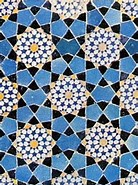Believe it or not, tessellation is something surrounding us in our daily lives. Look at the tiles in your bathroom, they will all be the same. Inside your kitchen? The tiles will show examples of tessellation as will the floor if it is wooden. Like chocolate? Who doesn’t?! Well that also shows tessellation as well as the skin on a pineapple. Like playing football? Well that ball is an example of tessellations using hexagons and pentagons.
Tessellation is the arrangement of one or more identical shapes that fit together perfectly to create a pattern. The most important thing about these shapes is that there should be no spaces or gaps within the pattern and that they are identical. By being identical I mean that all the shapes should be the same and the same size. When all of the shapes are the exact same then a tessellation occurs.
There are two different types of shapes that can occur within a tessellation, regular and irregular. The regular shapes include squares, hexagons and equilateral triangles whereas other triangles and quadrilaterals are irregular shapes. The difference between both of these is that with irregular shapes you have to rotate them in order to make them fit together and this is not necessary for regular shapes. All of these shapes are congruent which means that they are all the same size and even if you were to rotate a shape then it would still be the same. For example, if you rotate a circle then it is still a circle making it congruent. Regular shapes can create a tessellation as when all of the vertices touch one another then it all adds up to the sum of three hundred and sixty degrees.
Tessellations can be seen within the Islamic religion. The most common shapes that are used for tessellations within this religion is an equilateral triangle, a square and a hexagon. A star is also often used in the Islam religion and can differ between a 6, 8, 10 or 12 point star. A triangle is used a simple regular shape that represents harmony and a hum consciousness. The square is used as it highlights the four corners of the Earth while the hexagon that is used represents heaven.
Tessellations also relate to Liping Ma’s beliefs on profound understanding of fundamental mathematics. The basic idea within tessellations is the shapes that are used and how the fit with one another as well as the reasons why. This then leads on to longitudinal coherence as this basic idea can then lead to using this knowledge in order to explain more complicated concepts of area.
